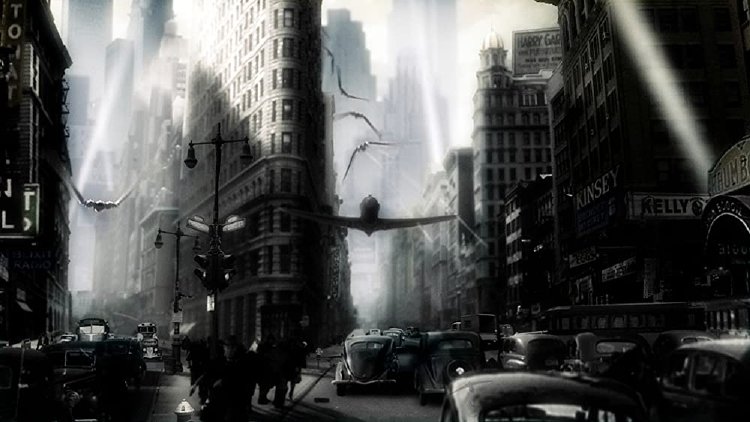Sky Captain and the World of Tomorrow

It’s circa 1939, but not the 1939 you may know about. In this fantastical world, giant flying robots attack Gotham City (AKA New York) and ace reporter Polly Perkins (Gwyneth Paltrow) is investigating the unexplained disappearance of the planet’s most famous scientists. With the impending destruction of the city by the evil Dr. Totenkopf (images of Laurence Olivier), she enlists the aid of her old friend Joe (Jude Law) to save the globe in “Sky Captain and the World of Tomorrow.”
Laura's Review: C
Robin's Review: C+
SCatWoT” is an extremely clever film that sets its roots deep in the soil of its influences like the old Buck Rogers,” “Superman” and “Flash Gordon” serials from the 30’s and 40’s. Creator/director/scribe Kerry Conran worked for years in front of his computer putting together a six minute short of his vision of the robot invasion of New York City. His work found its way into the hands of producer Jon Avnet, $70 million was funded and Conran joined that small (but growing) pantheon of filmmakers that meld live action and CGI together. Shooting his principle cast in front of blue screen, the director creates a comic book vision of his computer-animated past/future world.
Tearing more than a few pages from the works of H.G. Wells, Conran mixes the traditional settings and look of the 1930’s with a world that is rife with futuristic robotic machines sent to destroy mankind. At the bottom of this destruction is the sinister Dr. Totenkopf – depicted with the photographed and archival film visage of the late Laurence Olivier – who has unleashed his mechanical minions upon the innocent people of Planet Earth. The annihilation of mankind seems assured until Sky Captain (Law), in his trusty P-40 Tomahawk, takes on the destructive power of Totenkopf and his machines – with the help of the beautiful Polly.
I’m trying to think of another film that totally eschews real sets and physical backdrops in favor of an entirely computer-generated “set” for its actors. None come readily to mind. Kerry Conran (with the $70 mil that producer Avnet procured) borrows liberally from many sources, besides H.G. Wells, to create a science fiction world that pays true homage to its serial roots. As I watched “SCatWoT” I started to note the film influences and references that abound. “War of the Worlds,” “The Day the Earth Stood Still,” “Iron Giant,” “Gulliver’s Travels,” “Forbidden Planet,” Star Wars,” “King Kong,” “Godzilla,” “Metropolis,” The Matrix” and “The Wizard of Oz” all get shrift as the story of “Sky Captain and the World of Tomorrow” unfolds.
Paying tribute to these great films is a nice thing but detracts from story that centers “SCatWoT.” The vision that Conran works from is interesting and there is certainly lots to look at. However, as the story plays out, I was less than satisfied with the dialog and direction of the veteran cast. Sure, this is comic book stuff, but that doesn’t mean that the actors should be saddled with wooden dialog and two-dimensional characters. Neither Gwyneth Paltrow nor Jude Law are given roles that they can hang their hats upon – they could have been replaced, like the settings behind them, with CGI creations and we would have missed nothing. The same goes for the rest of the cast that includes Angelina Jolie as tough, one-eyed Frankie Cook (the leader of the all-girl amphibious attack squad), Giovanni Ribisi as Dex, the “brains” of the film (it is a stretch), and Michael Gambon, nearly invisible as Polly’s editor, Morris Paley. Bai Ling is speechless (literally) as the mysterious henchwoman for the equally mysterious Dr. T. (Laurence Olivier fared best as the enigmatic bad guy – but he’s dead!)
One of the problems I have with “SCatWoT” dialog and story is the blurring of history and the misuse of terms. The story takes place in the fantastical world of 1939 New York City – we know it is 1939 when Polly goes to the Radio City Music Hall for a clandestine meeting and “The Wizard of Oz” is playing on the big screen. Presumably, Adolph Hitler has not started the Second World War, yet, but several times characters refer to the “First World War,” rather than “The Great War,” as it would be known at the time. This is a minor point, maybe, but common to the I’m-so-clever nature of the script by Conran.
The real draw for the sci-fi fans is the CGI creation of Sky Captain’s World of Tomorrow – that name taken directly from the title of the 1939 New York World’s Fair. And, I have to admit, in its sterile way it has a goodly amount of technical eye candy to keep you somewhat interested. This is a good thing as the story, by the director, is lackluster and has few surprises. You are visually challenged in watching SCatWoT” and all of its references but there is not a lot to keep the mind occupied as the good guys jump through their assigned hoops to stop the enigmatic bad guys.
CGI fans will go see “Sky Captain and the World of Tomorrow” regardless of what the critics think. This critic applauds the technical effort by Kerry Conran and company but I also wonder what it would have been like in the hands of an experienced director and a first-rate scripter. Instead of merely interesting, it could have been great.

